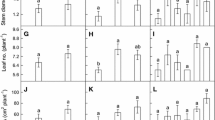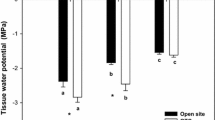Abstract
Kudzu (Pueraria lobata (Willd) Ohwi.) is a vine which forms large, monospecific stands in disturbed areas of the southeastern United States. Kudzu also emits isoprene, a hydrocarbon which can significantly affect atmospheric chemistry including reactions leading to tropospheric ozone. We have studied physiological aspects of isoprene emission from kudzu so the ecological consequences of isoprene emission can be better understood. We examined: (a) the development of isoprene emission as leaves developed, (b) the interaction between photon flux density and temperature effects on isoprene emission, (c) isoprene emission during and after water stress, and (d) the induction of isoprene emission from leaves grown at low temperature by water stress or elevated temperature. Isoprene emission under standard conditions of 1000 μmol photons·m-2·s-1 and 30°C developed only after the leaf had reached full expansion, and was not complete until up to two weeks past the point of full expansion of the leaf. The effect of temperature on isoprene emission was much greater than found for other species, with a 10°C increase in temperature causing a eight-fold increase in the rate of isoprene emission. Isoprene emission from kudzu was stimulated by increases in photon flux density up to 3000 μmol photons·m-2·s-1. In contrast, photosynthesis of kudzu was saturated at less than 1000 μmol·m-2·s-1 photon flux density and was reduced at high temperature, so that up to 20% of the carbon fixed in photosynthesis was reemitted as isoprene gas at 1000 μmol photons·m-2·s-1 and 35°C. Withholding water caused photosynthesis to decline nearly to zero after several days but had a much smaller effect on isoprene emission. Following the relief of water stress, photosynthesis recovered to the prestress level but isoprene emission increased to about five times the prestress rate. At 1000 μmol photons·m-2·s-1 and 35°C as much as 67% of the carbon fixed in photosynthesis was reemitted as isoprene eight days after water stress. Leaves grown at less than 20°C did not make isoprene until an inductive treatment was given. Inductive treatments included growth at 24°C, leaf temperature of 30°C for 5 h, or witholding water from plants. With the new information on temperature and water stress effects on isoprene emission, we speculate that isoprene emission may help plants cope with stressful conditions.
Similar content being viewed by others
References
Brasseur GP, Chatfield RB (1991) The fate of biogenic trace gases in the atmosphere. In: Sharkey TD, Holland EA, Mooney HA (eds) Trace gas emission from plants, Academic Press, San Diego, pp 1–27
Brown MS, Goldstein JL (1980) Multivalent feedback regulation of HMG CoA reductase, a control mechanism coordinating isoprenoid synthesis and cell growth. J Lip Res 21: 505–517
Chameides WL, Lodge JP (1992) Tropospheric ozone: Formation and fate: In Lefohn AS (ed) Surface level ozone exposures and their effects on vegetation. Lewis Publishers, Inc., Chelsea, MI, pp 5–30
Chameides WL, Lindsay RW, Richardson J, Kiang CS (1988) The role of biogenic hydrocarbons in urban photochemical smog: Atlanta as a case study. Science 241: 1473–1475
Forseth IN, Teramura AH (1986) Kudzu leaf energy budget and calculated transpiration: the influence of leaflet orientation. Ecology 67: 564–571
Forseth LN, Teramura AH (1987) Field photosynthesis, microclimate and water relations of an exotic temperate liana, Pueraria lobata, kudzu. Oecologia 71: 262–267
Grinspoon J, Bowman WD, Fall R (1991) Delayed onset of isoprene emission in developing velvet bean (Mucuna sp.) leaves. Plant Physiol 97: 170–174
Hoagland DR, Arnon DI (1938) The water culture method for growing plants without soil, Berkeley: UC Agric Exp Sta Circular 347: 1–39
Kuzma J, Fall R (1993) Leaf isoprene emission rate is dependent on leaf development and the level of isoprene synthase. Plant Physiol 101: 435–440
Lamb B, Guenther A, Gay D, Westberg H (1987) A national inventory of biogenic hydrocarbon emissions. Atmos Environ 21: 1695–1705
Loreto F, Sharkey TD (1990) A gas-exchange study of photosynthesis and isoprene emission in Quercus rubra L. Planta 182: 523–531
Loreto F, Sharkey TD (1992) On the relationship between isoprene emission and photosynthetic metabolites under different environmental conditions. Planta 189: 420–424
Monson RK, Fall R (1989) Isoprene emission from Aspen leaves. The influence of environment and relation to photosynthesis and photorespiration. Plant Physiol 90: 267–274
Monson RK, Guenther AB, Fall R (1991) Physiological reality in relation to ecosystem- and global-level estimates of isoprene emission. In: Sharkey TD, Holland EA, Mooney HA (eds) Trace gas emissions from plants. Academic Press, San Diego, pp 185–207
Monson RK, Jaeger CH, Adams WW III, Driggers EM, Silver GM, Fall R (1992) Relationships among isoprene emission rate, photosynthesis, and isoprene synthase activity as influenced by temperature. Plant Physiol 98: 1175–1180
Rasmussen RA (1972) What do the hydrocarbons from trees contribute to air pollution. J Air Pollut Control Assoc 22: 537–543
Sharkey TD, Loreto F, Delwiche CF (1991) The biochemistry of isoprene emission from leaves during photosynthesis. In: Sharkey TD, Holland EA, Mooney HA (eds) Trace gas emissions from plants. Academic Press, San Diego, pp 153–184
Silver GM, Fall R (1991) Enzymatic synthesis of isoprene from dimethylallyl diphosphate in aspen leaf extracts. Plant Physiol 97: 1588–1591
Thompson AM (1992) The oxidizing capacity of the Earth's atmosphere: probable past and future changes. Science 256: 1157–1165
Tingey DT, Manning M, Grothaus LC, Burns WF (1979) The influence of light and temperature on isoprene emission rates from live oak. Plant Physiol 47: 112–118
Tingey DT, Evans RC, Bates EH, Gumpertz ML (1987) Isoprene emissions and photosynthesis in three ferns — The influence of light and temperature. Plant Physiol 69: 609–616
Trainer M, Williams EJ, Parrish DD, Buhr MP, Allwine EJ, Westberg HH, Fehsenfeld FC, Liu SC (1987) Models and observations of the impact of natural hydrocarbons on rural ozone. Nature 329: 705–707
Went FW (1960) Blue hazes in the atmosphere. Nature 187: 641–643
Zimmerman PR, Chatfield RB, Fishman J, Crutzen PJ, Hanst PL (1978) Estimates on the production of CO and H2 from the oxidation of hydrocarbon emissions from vegetation. Geophys Res Lett 5: 679–682
Author information
Authors and Affiliations
Rights and permissions
About this article
Cite this article
Sharkey, T.D., Loreto, F. Water stress, temperature, and light effects on the capacity for isoprene emission and photosynthesis of kudzu leaves. Oecologia 95, 328–333 (1993). https://doi.org/10.1007/BF00320984
Received:
Accepted:
Issue Date:
DOI: https://doi.org/10.1007/BF00320984




